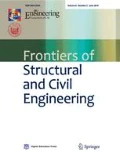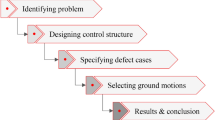Abstract
Proven research output on the behavior of structures made of waste copper slag concrete can improve its utilization in the construction industry and thereby help to develop a sustainable built environment. Although numerous studies on waste copper slag concrete can be found in the published literature, no research has focused on the structural application of this type of concrete. In particular, the variability in the strength properties of waste copper slag concrete, which is required for various structural applications, such as limit state design formulation, reliability-based structural analysis, etc., has so far not attracted the attention of researchers. This paper quantifies the uncertainty associated with the compressive-, flexural- and split tensile strength of hardened concrete with different dosages of waste copper slag as fine aggregate. Best-fit probability distribution models are proposed based on statistical analyses of strength data generated from laboratory experiments. In addition, the paper presents a reliability-based seismic risk assessment of a typical waste copper slag incorporated reinforced concrete framed building, considering the proposed distribution model. The results show that waste copper slag can be safely used for seismic resistant structures as it results in an identical probability of failure and dispersion in the drift demand when compared with a conventional concrete building made of natural sand.
Similar content being viewed by others
References
Paris J M, Roessler J G, Ferraro C C, de Ford H D, Townsend T G. A review of waste products utilized as supplements to Portland cement in concrete. Journal of Cleaner Production, 2016, 121: 1–18
Shah S N, Mo K H, Yap S P, Yang J, Ling T C. Lightweight foamed concrete as a promising avenue for incorporating waste materials: A review. Resources, Conservation and Recycling, 2021, 164: 105103
Kirthika S K, Singh S K, Chourasia A. Alternative fine aggregates in production of sustainable concrete—A review. Journal of Cleaner Production, 2020, 268: 122089
Dash M K, Patro S K, Rath A K. Sustainable use of industrial-waste as partial replacement of fine aggregate for preparation of concrete—A review. International Journal of Sustainable Built Environment, 2016, 5(2): 484–516
Tavakoli D, Hashempour M, Heidari A. Use of waste materials in concrete: A review. Pertanika Journal of Science & Technology, 2018, 26(2): 499–522
Collivignarelli M C, Cillari G, Ricciardi P, Miino M C, Torretta V, Rada E C, Abbà A. The production of sustainable concrete with the use of alternative aggregates: A review. Sustainability, 2020, 12(19): 7903
Zhang X, Li W, Tang Z, Wang X, Sheng D. Sustainable regenerated binding materials (RBM) utilizing industrial solid wastes for soil and aggregate stabilization. Journal of Cleaner Production, 2020, 275: 122991
Mistri A, Bhattacharyya S K, Dhami N, Mukherjee A, Barai S V. Petrographic investigation on recycled coarse aggregate and identification the reason behind the inferior performance. Construction & Building Materials, 2019, 221: 399–408
Kisku N, Joshi H, Ansari M, Panda S K, Nayak S, Dutta S C. A critical review and assessment for usage of recycled aggregate as sustainable construction material. Construction & Building Materials, 2017, 131: 721–740
Al-Jabri K S, Hisada M, Al-Saidy A H, Al-Oraimi S K. Performance of high strength concrete made with copper slag as a fine aggregate. Construction & Building Materials, 2009, 23(6): 2132–2140
Shi C, Meyer C, Behnood A. Utilization of copper slag in cement and concrete. Resources, Conservation and Recycling, 2008, 52(10): 1115–1120
Arino A M, Mobasher B. Effect of ground copper slag on strength and toughness of cementitious mixes. ACI Materials Journal, 1999, 96(1): 68–73
Tixier R, Devaguptapu R, Mobasher B. The effect of copper slag on the hydration and mechanical properties of cementitious mixtures. Cement and Concrete Research, 1997, 27(10): 1569–1580
Moura W A, Gonçalves J P, Lima M B L. Copper slag waste as a supplementary cementing material to concrete. Journal of Materials Science, 2007, 42(7): 2226–2230
Gorai B, Jana R K, Premchand. Characteristics and utilization of copper slag—A review. Resources, Conservation and Recycling, 2003, 39(4): 299–313
Al-Jabri K S, Al-Saidy A H, Taha R. Effect of copper slag as a fine aggregate on the properties of cement mortars and concrete. Construction & Building Materials, 2011, 25(2): 933–938
Wu W, Zhang W, Ma G. Optimum content of copper slag as a fine aggregate in high strength concrete. Materials & Design, 2010, 31(6): 2878–2883
Alnuaimi A S. Effects of copper slag as a replacement for fine aggregate on the behavior and ultimate strength of reinforced concrete slender columns. Journal of Engineering Research, 2012, 9(2): 90–102
Murari K, Siddique R, Jain K K. Use of waste copper slag, a sustainable material. Journal of Material Cycles and Waste Management, 2015, 17(1): 13–26
Ambily P S, Umarani C, Ravisankar K, Prem P R, Bharatkumar B H, Iyer N R. Studies on ultra-high performance concrete incorporating copper slag as fine aggregate. Construction & Building Materials, 2015, 77: 233–240
Mavroulidou M. Mechanical properties and durability of concrete with water cooled copper slag aggregate. Waste and Biomass Valorization, 2017, 8(5): 1841–1854
Zaidi K A, Ram S, Gautam M K. Utilization of glass powder in high strength copper slag concrete. Advances in Concrete Construction, 2017, 5(1): 65–74
Raju S, Dharmar B. Durability characteristic of copper slag concrete with fly ash. Gradevinar, 2017, 69(11): 1031–1040
Thomas J, Thaickavil N N, Abraham M P. Copper or ferrous slag as substitutes for fine aggregate in concrete. Advances in Concrete Construction, 2018, 6(5): 545–560
Nowak A S, Collins K R. Reliability of Structures. New York: McGraw-Hill, 2000
Kilinc K, Celik A O, Tuncan M, Tuncan A, Arslan G, Arioz O. Statistical distributions of in-situ micro core concrete strength. Construction & Building Materials, 2012, 26(1): 393–403
Campbell R H, Tobin R E. Core and cylinder strengths of natural and lightweight concrete. Journal of Materials in Civil Engineering, 1967, 64(4): 190–195
Soroka I. An application of statistical procedures to quality control of concrete. Materiales de Construcción, 1968, 1(5): 437–441
Chmielewski T, Konopka E. Statistical evaluations of field concrete strength. Magazine of Concrete Research, 1999, 51(1): 45–52
Graybeal B, Davis M. Cylinder or cube: Strength testing of 80 to 200 MPa (11. 6 to 29 ksi) ultra-high-performance fiber-reinforced concrete. ACI Materials Journal, 2008, 105(6): 603–609
Chen X, Wu S, Zhou J. Variability of compressive strength of concrete cores. Journal of Performance of Constructed Facilities, 2014, 28(4): 06014001
Pacheco J, De Brito J, Chastre C, Evangelista L. Experimental investigation on the variability of the main mechanical properties of concrete produced with coarse recycled concrete aggregates. Construction & Building Materials, 2019, 201: 110–120
Sahoo K, Dhir P K, Teja P R R, Sarkar P, Davis R. Variability of silica fume concrete and its effect on seismic safety of reinforced concrete buildings. Journal of Materials in Civil Engineering, 2020, 32(4): 04020024
Sahoo K, Kumar Dhir P, Teja P R R, Sarkar P, Davis R. Seismic safety assessment of buildings with fly-ash concrete. Practice Periodical on Structural Design and Construction, 2020, 25(3): 04020024
ASTM. Standard Specification for Portland Cement, ASTM C150/C150M. West Conshohocken, PA: ASTM, 2019
ASTM. Standard Specification for Concrete Aggregates, ASTM C33/C33M. West Conshohocken, PA: ASTM, 2018
Panda S, Sarkar P, Davis R. Abrasion resistance and slake durability of copper slag aggregate concrete. Journal of Building Engineering, 2021, 35: 101987
ASTM. Standard Practice for Making and Curing Concrete Test Specimens in the Laboratory, ASTM C192/C192M. West Conshohocken, PA: ASTM, 2016
IS. Method of Tests for Strength of Concrete. Bureau of Indian Standards, IS 516. New Delhi: IS, 1959
ASTM. Standard Test Method for Splitting Tensile Strength of Cylindrical Concrete Specimens, ASTM C496. West Conshohocken, PA: ASTM, 2017
ASTM. Standard Test Method for Flexural Strength of Concrete Specimens, ASTM C293. West Conshohocken, PA: ASTM, 2016
Lilliefors H W. On the Kolmogorov-Smirnov test for normality with mean and variance unknown. Journal of the American Statistical Association, 1967, 62(318): 399–402
Sahu S, Sarkar P, Davis R. Uncertainty in bond strength of unreinforced fly-ash brick masonry. Journal of Materials in Civil Engineering, 2020, 32(3): 06020003
Stephens M A. EDF statistics for goodness of fit and some comparisons. Journal of the American Statistical Association, 1974, 69(347): 730–737
Lawrence S J. Random Variations in Brickwork Properties. 7th ed. Melbourne: Brick Masonry Conference, 1985: 537–547
Montazerolghaem M. Analysis of unreinforced masonry structures with uncertain data. Dissertation for the Doctoral Degree. Dresden: Dresden University of Technology, 2015
Sorrentino L, Infantino P, Liberatore D. Statistical tests for the goodness of fit of mortar compressive strength distributions. In: The 16th International Brick and Block Masonry Conference. Italy: CRC Press, 2016
Sahu S, Sarkar P, Davis R. Quantification of uncertainty in compressive strength of fly ash brick masonry. Journal of Building Engineering, 2019, 26: 100843
Chandrappa A K, Biligiri K P. Flexural-fatigue characteristics of pervious concrete: Statistical distributions and model development. Construction & Building Materials, 2017, 153: 1–15
Forbes C, Evans M, Hastings N, Peacock B. Statistical Distributions. 4th ed. New York: Wiley, 2011
EasyFit. Version 5.6. Dnepropetrovsk: MathWave Technologies. 2015
Sun D, Wu K, Shi H, Zhang L, Zhang L. Effect of interfacial transition zone on the transport of sulfate ions in concrete. Construction & Building Materials, 2018, 192: 28–37
Sun D, Wu K, Shi H, Miramini S, Zhang L. Deformation behavior of concrete materials under the sulfate attack. Construction & Building Materials, 2019, 210: 232–241
Sun D, Shi H, Wu K, Miramini S, Li B, Zhang L. Influence of aggregate surface treatment on corrosion resistance of cement composite under chloride attack. Construction & Building Materials, 2020, 248: 118636
Cornell C A, Jalayer F, Hamburger R O, Foutch D A. Probabilistic Basis for 2000 SAC Federal Emergency Management Agency Steel Moment Frame Guidelines. Journal of Structural Engineering, 2002, 128(4): 526–533
Celik O C, Ellingwood B R. Seismic fragilities for non-ductile reinforced concrete frames—Role of aleatoric and epistemic uncertainties. Structural Safety, 2010, 32(1): 1–12
Bhosale A S, Davis R, Sarkar P. Seismic safety of vertically irregular buildings: Performance of existing indicators. Journal of Architectural Engineering, 2018, 24(3): 04018013
Haran Pragalath D C, Bhosale A S, Davis R, Sarkar P. Multiplication factor for open ground story buildings: A reliability-based evaluation. Earthquake Engineering and Engineering Vibration, 2016, 15(2): 283–295
IS. Indian Standard Criteria for Earthquake Resistant Design of Structures. Part 1 General provisions and buildings. Bureau of Indian Standards, IS 1893. New Delhi: IS, 2016
Integrated Software for Structural Analysis and Design. SAP2000. Version 22. Berkeley, CA: Computers and Structures, 2020
IS. Plain and Reinforced Concrete—Code of Practice. Bureau of Indian Standards, IS 456, New Delhi: IS 456, 2000
McKenna F, McGann C, Arduino P, Harmon J A. Open Sees laboratory. 2018 (Available at the website of OpenSees)
Haselton C B, Whittaker A S, Hortacsu A, Baker J W, Bray J, Grant D N. Selecting and scaling earthquake ground motions for performing response-history analyses. In: The 15th World Conference on Earthquake Engineering. Lisbon: Earthquake Engineering Research Institute, 2012: 4207–4217
Haran P D C, Davis R, Sarkar P. Reliability evaluation of RC frame by two major fragility analysis methods. Asian Journal of Civil Engineering, 2015, 16(1): 47–66
Author information
Authors and Affiliations
Corresponding author
Rights and permissions
About this article
Cite this article
Panda, S., Zade, N.P., Sarkar, P. et al. Variability of waste copper slag concrete and its effect on the seismic safety of reinforced concrete building: A case study. Front. Struct. Civ. Eng. 16, 117–130 (2022). https://doi.org/10.1007/s11709-021-0788-7
Received:
Accepted:
Published:
Issue Date:
DOI: https://doi.org/10.1007/s11709-021-0788-7




